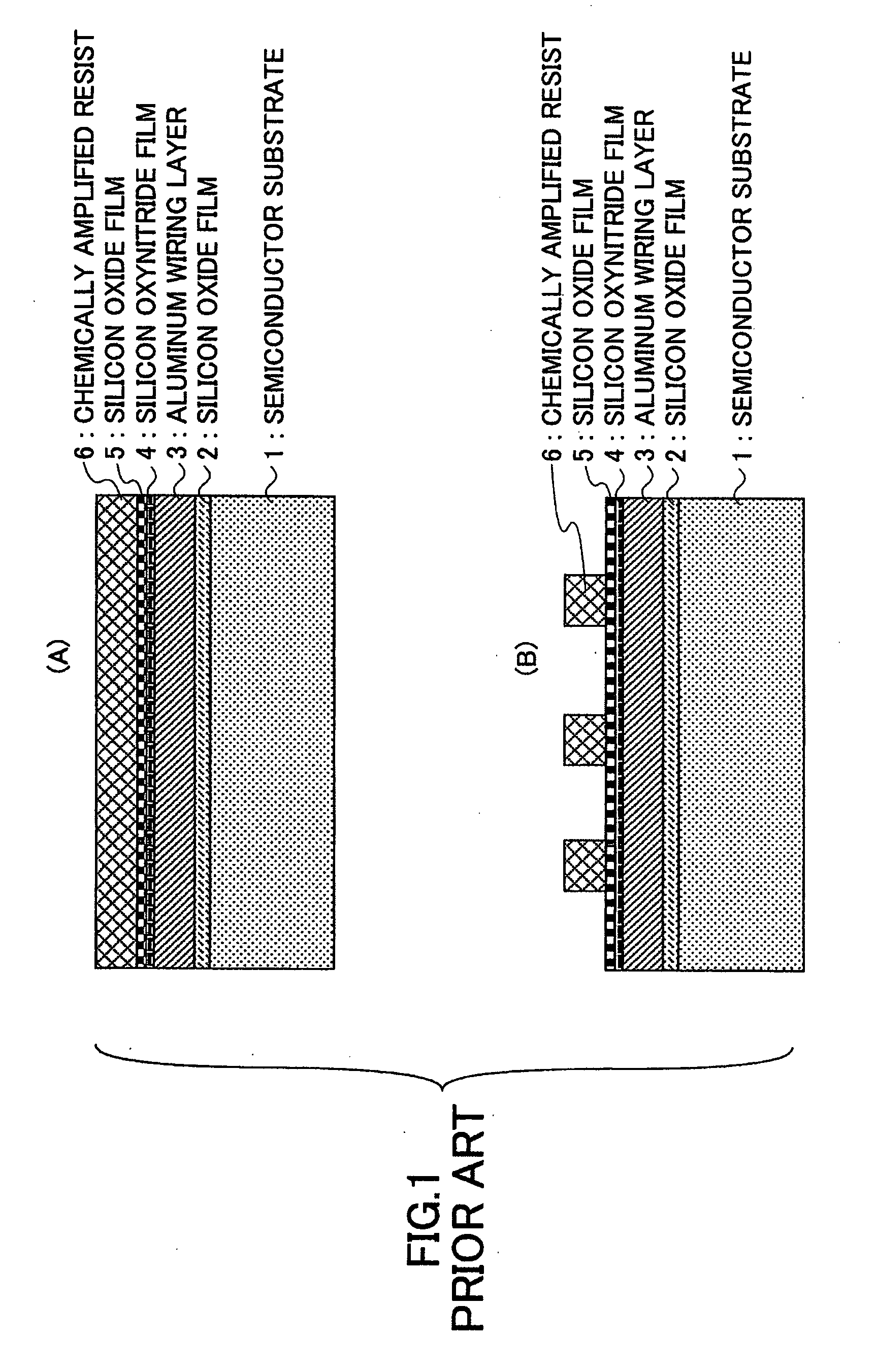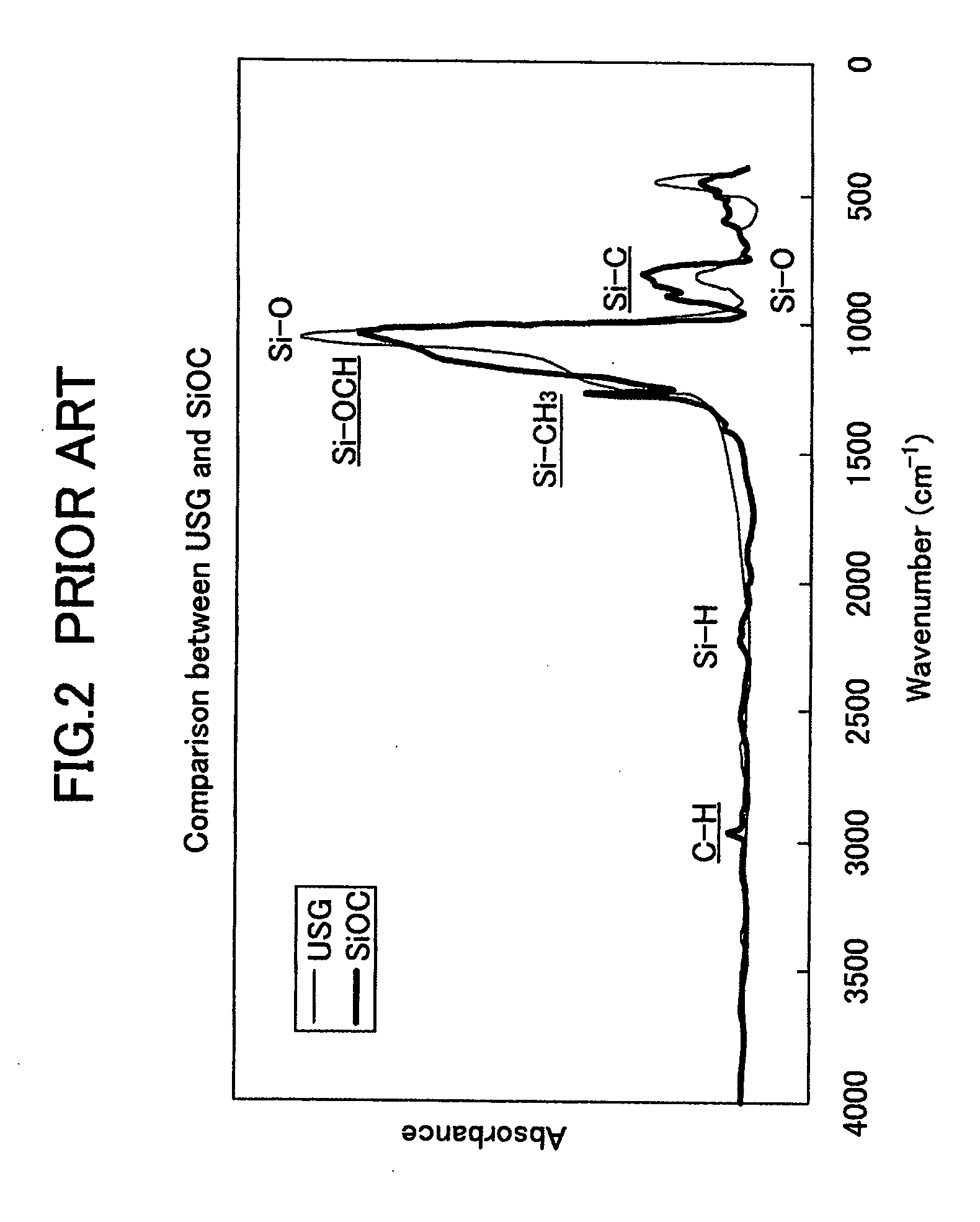Method of making a semiconductor device with residual amine group free multilayer interconnection
a multi-layer interconnection and semiconductor technology, applied in semiconductor/solid-state device details, photomechanical apparatus, semiconductor devices, etc., can solve the problems of preventing the oxidation reaction of the chemically amplified, unable to form a wiring pattern groove, and unstable silicon oxynitride film b>4/b>, etc., to achieve excellent patterning
- Summary
- Abstract
- Description
- Claims
- Application Information
AI Technical Summary
Benefits of technology
Problems solved by technology
Method used
Image
Examples
first embodiment
[0123]FIGS. 16 through 31 illustrate a process of manufacturing a semiconductor device in accordance with a first embodiment of the present invention. In this manufacturing process, a SiOC film that is an interlayer insulating film is patterned using a dual damascene process and a reflection preventing film.
Step of Forming a Contact Pattern
[0124]Referring to FIG. 16, after the formation of a circuit device (not shown) on a semiconductor substrate 101, a silicon nitride film 111 and a silicon oxide film 151 are formed on the semiconductor substrate 101. To flatten the area of the circuit device (not shown), the silicon oxide film 151 is polished by a CMP method. After that, a chemically amplifier resist film for forming a contact pattern (not shown) is patterned on the silicon oxide film 151. With the chemically amplified resist film being the mask, etching is performed to form a contact hole (not shown). A tight contact layer 121 and a tungsten film 131 are then formed in the contac...
second embodiment
[0143]Although the USG film 252 as a diffusion preventing film is formed between the SiOC film 163 and the silicon nitride film 302 as a reflection preventing film in the first embodiment of the method of manufacturing a semiconductor device, a SiC film not containing N as a growth gas may be employed instead of the USG film 252.
[0144]The growth gases for a SiC film include tetramethylsilane (Si(CH3)4) and CO2, as described earlier.
[0145]A SiC film as a diffusion preventing film is formed on the SiOC film 163, and the silicon nitride film 302 as a reflection preventing film is then formed on the SiC film. With this structure, the N2 gas generated during the formation of the silicon nitride film 302 as a reflection preventing film can be prevented from diffusing into the SiOC film 163 formed under the silicon nitride film 302 as a reflection preventing film. Also, the N2 gas can be prevented from reacting with the H group contained in the SiOC film 163, and generation of an amine gro...
third embodiment
[0146]Although the USG film 252 as a diffusion preventing film is formed between the SiOC film 163 and the silicon nitride film 302 as a reflection preventing film in the first embodiment of the method of manufacturing a semiconductor device, a PSG film not containing N as a growth gas may be employed instead of the USG film 252.
[0147]The growth gases for a PSG film include PH3, O2, and He.
[0148]More specifically, a PSG film as a diffusion preventing film is formed on the SiOC film 163, and the silicon nitride film 302 as a reflection preventing film is then formed on the PSG film. With this structure, the N2 gas generated during the formation of the silicon nitride film 302 as a reflection preventing film can be prevented from diffusing into the SiOC film 163 formed under the SiN film 302. Also, the N2 gas can be prevented from reacting with the H group in the SiOC film 163, and generation of an amine group such as NH in the SiOC film 163 can be prevented. Thus, the dissolution hin...
PUM
| Property | Measurement | Unit |
|---|---|---|
| thickness | aaaaa | aaaaa |
| thickness | aaaaa | aaaaa |
| wavelength | aaaaa | aaaaa |
Abstract
Description
Claims
Application Information
 Login to View More
Login to View More - R&D
- Intellectual Property
- Life Sciences
- Materials
- Tech Scout
- Unparalleled Data Quality
- Higher Quality Content
- 60% Fewer Hallucinations
Browse by: Latest US Patents, China's latest patents, Technical Efficacy Thesaurus, Application Domain, Technology Topic, Popular Technical Reports.
© 2025 PatSnap. All rights reserved.Legal|Privacy policy|Modern Slavery Act Transparency Statement|Sitemap|About US| Contact US: help@patsnap.com



